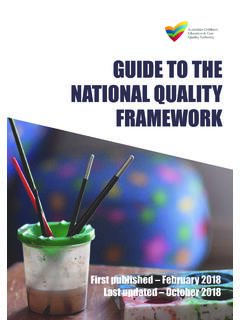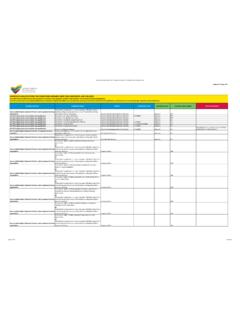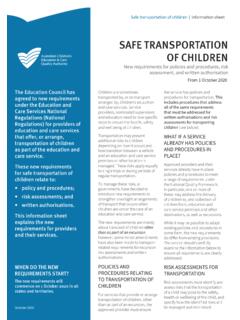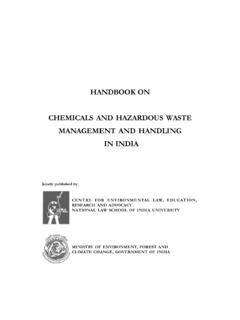Transcription of National Quality Standard Information sheet - ACECQA
1 LINKS TO THE National Quality STANDARDThe importance of providing inclusive and sustainable learning environments that maximise and promote children s learning is reflected under Quality Area 3 of the National Quality Standard (NQS) in particular: Standard : The service environment is inclusive, promotes competence and supports exploration and play-based learning. Element : Outdoor and indoor spaces are organised and adapted to support every child s participation and to engage every child in Quality experiences in both built and natural environments. Element : Resources, materials and equipment allow for multiple uses, are sufficient in number, and enable every child to engage in play-based learning.
2 Standard : The service cares for the environment and supports children to become environmentally responsible. INTENT AND PURPOSE Considering the environment in ways that are intentional and purposeful helps to: foster encounters, encourage communication and relationships create environments filled with natural light, order and wonder invite children to delve deeper, investigate and represent their learning through a range of a shared responsibility Sustainable environments promote the idea of children as partners and collaborators in their learning. These spaces have the potential to support children s understanding of the environment , sustainable practices and their inherent responsibilities as global citizens.
3 Children s agency Whatever the skills and abilities of the child and the type of education and care service, the environment should promote each child s sense of agency. Physical spaces should allow children to be active contributors and have an influence in their world. This involves children contributing to make the environment safe, for example, using equipment and resources in an appropriate Quality Standard | Information sheetQUALITY AREA 3 THE environment AS THE THIRD TEACHER Quality Area 3 | The environment as the third teacher Contemporary theories and research informed by the Reggio Emilia approach recognise and value the environment as a third teacher.
4 Behind educators and families, physical spaces hold the potential to influence what and how children learn. Things to consider: How does the physical space of the service encourage children s agency? How is learning built into the environment ? What learning opportunities are created by changing the space, for example by adding or taking away resources or equipment? How can collaboration with children, families and service staff help create sustainable environments? How do the different spaces of the service foster a sense of belonging and community? How does the environment reflect and honour Aboriginal and Torres Strait Islander history and culture?
5 Quality Area 3 | The environment as the third teacher February 2018 ENGAGINGL earning environments engage and foster a sense of ownership and respect when they are aesthetically pleasing, reflect the identity and culture of children and families, and encourage a connection to place. As such, the physical environment is never simply a backdrop to the curriculum; it is an integral part of the curriculum or leisure based program. An environment with rich and built-in learning opportunities also frees educators to interact with characteristics of engaging environments include:Interesting thingsNatural materials and things of interest for children to see, touch and smell have an inherently higher degree of complexity in terms of patterning and materials Areas dedicated to different experiences such as art and craft, books and literacy, blocks and building materials, can help children s engagement and learning.
6 For example, a pine cone can be used as a prop for dramatic play or an item for construction. This is especially important when supporting a wide range of ages, abilities and learning balance of experiencesA balance of experiences facilitates shared thinking, including exploration, experimentation and hypothesising. Areas dedicated to experiences for example, art and craft, books and literacy, blocks and building materials can help children s engagement and learning. The key here is for educators to be flexible about what experiences happen and accessJust as educators should embrace a flexible approach to experiences, they should also provide and encourage the flexible use and access to resources and equipment.
7 This responds to children s agency and interest in both indoor and outdoor and repurposing Reusing, recycling, rethinking and repurposing of resources, furniture and equipment promotes an awareness of sustainable practices. This provides opportunities for children to problem solve and be creative in ways that develop their respect for the environment and thoughtful use of limited natural familiar and the novelBalancing sameness and change, the familiar and the novel, responds to children s need for both. Often small changes in the environment can be enough to ensure the environment is interesting and engaging, especially for very young children.
8 Talking with children about possible changes and involving them in decision making supports their agency, influence and learning and can reduce stress resulting from too much AND RESPECTFUL Respect for children as collaborators and partners with educators in their learning is central to the approved learning frameworks. Environments that are respectful of children s emerging skills and competencies provide opportunities for them to make their own decisions and to act independently. These environments: Encourage children to make choices, including whether to be with others or to be on their own. Arranging furniture to create areas can encourage children to disperse and be together by choice.
9 Big open spaces that force children into large or small groups may interfere with these positive interactions. Support children to feel secure, and the equipment and furniture allows children to do things for themselves. Chairs that allow feet to touch the floor, sinks that are child height (or stable stools that allow children to safely reach the sink or get on the toilet themselves), tables and chairs that support backs while sitting, and lockers with hooks that are accessible all encourage children to exercise agency. Include displays of children s work that are uncluttered and involve children in making decisions about whose work is displayed and how these are changed.
10 It is important to acknowledge and honour the efforts of all children in meaningful and respectful ways. For example, working with children to identify work to be displayed may be more empowering than wallpapering with stencils or templated art work. Create a vibrant and responsive space. Think about how much fixed equipment is necessary both indoors and outdoors, make changes as children s needs and interests evole and create a sense of discovery. Allow for children s works in progress to be preserved over days or even PHYSICAL environment IS NEVER SIMPLY A BACKDROP TO THE CURRICULUM; IT IS AN INTEGRAL PART OF THE CURRICULUM OR LEISURE BASED PROGRAM.













